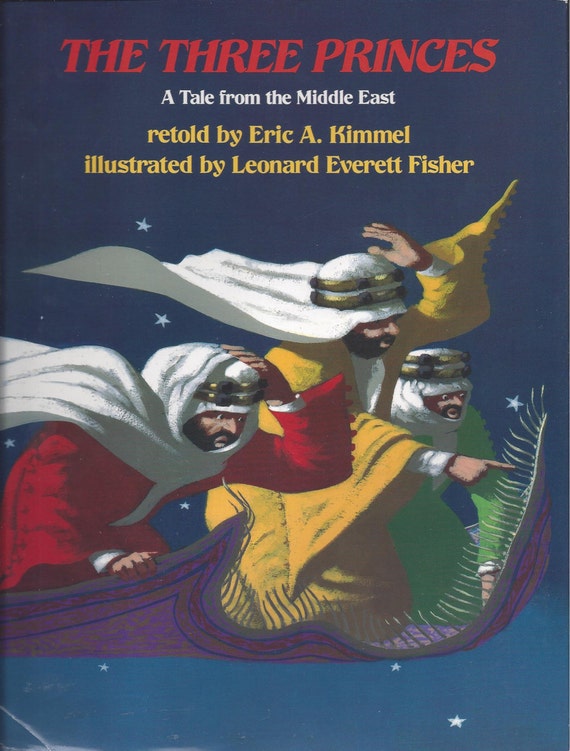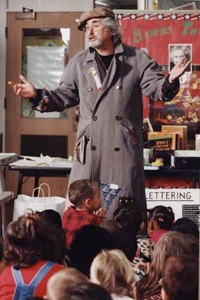Title: The Three Princes: A Tale from the Middle East
Retold by: Eric A. Kimmel
Illustrator: Leonard Everett Fisher
Publisher: New York: Holiday House, 1994
ISBN: 0-8234-1115-X
Plot Summary: A wise and beautiful princess must choose
between three suitors: Princes Fahad, Muhammed, and Mohsen. Each prince is an
acceptable match by bloodline, but although the princess likes Mohsen best, he
is poor and her counselors do not see Mohsen as being the preferable partner.
Being wise, the princess must base her decision on more than affection.
Therefore she send the princes on a quest to find a great wonder and present it
to her in one year’s time—giving Mohsen the opportunity to bring something that
will demonstrate his worth to her government. While they are absent the
princess becomes deathly ill. Working together and using the wonders they have
discovered, the princes heal the princess. Although all were involved in her
recovery, Mohsen sacrificed his wonder while Muhammed and Fahad retained
theirs. Thus proving his merit, the princess and Mohsen marry.
Critical Analysis: Kimmel and Fisher adaptation of “The
Three Princes” captures the essence of the ancient Arabian world and places it
in our hands through this picture book. The simple plot—a quest to win the hand
of a princess—is made extraordinary by one character, a wise and beautiful
princess. She is a strong and subtle leader of her kingdom, able to juggle her
heart and her government’s concerns, articulated through her chief minister the
wazir. Her personality and power dominate the story; the princes wooing seem
commonplace by comparison. At the beginning of the story Prince Mohsen is prominent
only because he’s the one she loves. By the end of the story Prince Mohsen’s
claim on the princess is still her love for him because although he used up his
wonder in healing her, there is no indication that the other princes wouldn’t
have done the same.
Kimmel’s text is formal, but not stiff or meager. The story
is told as matter-of-fact, even the existence of the magical wonders collected
by the princes does not provoke excitement in the reader. The illustrations
support the mildness; only the scene depicting the princes flying on a carpet
provides any sense of movement or urgency.
Oddly, the calm consistency of the text and illustrations is
exactly what the story needs. It evokes the unchanging desert in which the
story originates. The illustrations suggest the sand—concurrently smooth and
harsh. The chalk medium allows Fisher to smudge and obscure details as well as
stipple shadows that seem to be made of black sand. The primary cultural
markers are the robes worn by the characters and a crescent moon and star in
the night sky.
Most importantly, the tale brings us to a people wise and
peaceful. The universality of the themes—wisdom, sacrifice, and cooperation—are
appropriate and necessary to all cultures.
Reviews and Awards:
“Kimmel's sprightly retelling of a Middle Eastern folktale and Fisher's
ambient artwork shimmer with wisdom and magic.”--Publishers' Weekly
“A smooth,
accessible adaptation, much enhanced by the spare, powerful art.”--Kirkus Review
Eric Kimmel has received
numerous awards for his books, including: Caldecott Honor Medal, Sydney Taylor
Picture Book Award, National Jewish Book Award (twice), and the Naylor Award.
Leonard Fisher has
received numerous awards as well: 1950 Pulitzer Prize for Painting, Arbuthnot Citation,
National Jewish Book Award, Christopher Medal for Illustration, and many
others.
Discussion Prompts: (adapted from Hampton-Brown teacher guide)
Is it better to work together or alone?
When?
How would the
three princes answer this question?
The three princes have
to work together. Have you ever had to work in a group to solve a problem? What
did you like about it? What did you not like?
What if only two of the
princes agreed to work together and the third did not?
Lesson Plan about Middle
Eastern Folk Tales:
http://www.csames.illinois.edu/documents/outreach/Middle_Eastern_Folk_Tales_Lesson_Plan.pdf
Created for course 5603.21 at Texas Woman's University
Created for course 5603.21 at Texas Woman's University







